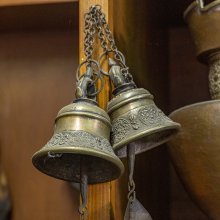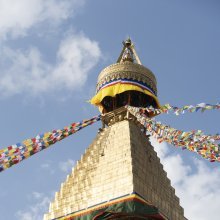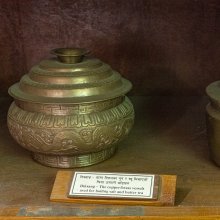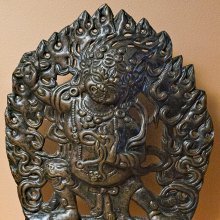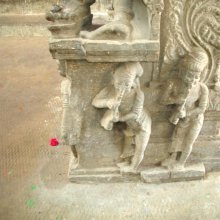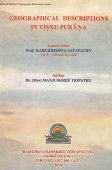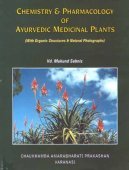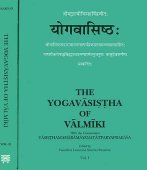Wind: 5 definitions
Introduction:
Wind means something in Hinduism, Sanskrit, the history of ancient India. If you want to know the exact meaning, history, etymology or English translation of this term then check out the descriptions on this page. Add your comment or reference to a book if you want to contribute to this summary article.
Images (photo gallery)
(+3 more images available)
In Hinduism
Yoga (school of philosophy)
Source: ORA: Amanaska (king of all yogas): A Critical Edition and Annotated Translation by Jason Birch1) (That which is) Wind is denoted by the Sanskrit term Vāyu (as opposed to Avāyu—‘windless’), according to the Bṛhadāraṇyikopaniṣat 3.8.6.—Accordingly, while describing the absolute nature of Brahma: “Gārgi said, ‘Yājñavalkya, that which is above the sky, below the earth, between the two and called [past, present and future], is stitched and cross-stitched in what?’ Yājñavalkya said, ‘Gārgi, the Brahmins call that very [thing] the imperishable one. [e.g., It is windless (avāyu) [...]’”.
2) Wind refers to one of the “five elemental powers” and represents one of the various signs and paranormal powers (siddhi) experienced by the Yoga practicioner, according to the Amanaska Yoga treatise (presented in the form of a dialogue between Īśvara and Vāmadeva).—The last fifty-two verses of the Amanaska’s first chapter describe a temporal sequence of psychosomatic signs and paranormal powers (siddhi) brought about by absorption (laya). In the Amanaska, The five elemental powers are, [e.g., wind (vāyu-tattva)], [...]

Yoga is originally considered a branch of Hindu philosophy (astika), but both ancient and modern Yoga combine the physical, mental and spiritual. Yoga teaches various physical techniques also known as āsanas (postures), used for various purposes (eg., meditation, contemplation, relaxation).
Natyashastra (theatrics and dramaturgy)
Source: Shodhganga: Elements of Art and Architecture in the Trtiyakhanda of the Visnudharmottarapurana (natya)Wind (as in, the natural phenomenon) is associated with Patāka-hasta: one of the twenty-two Single-hand Gestures (in Indian Dramas) (known as asaṃyuktahastas), according to the Viṣṇudharmottarapurāṇa, an ancient Sanskrit text which (being encyclopedic in nature) deals with a variety of cultural topics such as arts, architecture, music, grammar and astronomy.—The word patāka indicates dhvaja in Sanskrit which means flag or banner. [...] The Viṣṇudharmottarapurāṇa states that the dancer uses the patākahasta to obstruct prahāra i.e., stike or beat in a Dance performance. Moreover, to show the blowing of wind and raining, this hand posture is used in Dance. [...] In the Abhinayadarpaṇa, it is said that the patākahasta is used to denote the beginning of a drama. Moreover, this hand posture is used to symbolize some natural phenomenon like cloud, forest, bosom, river, wind etc.

Natyashastra (नाट्यशास्त्र, nāṭyaśāstra) refers to both the ancient Indian tradition (shastra) of performing arts, (natya—theatrics, drama, dance, music), as well as the name of a Sanskrit work dealing with these subjects. It also teaches the rules for composing Dramatic plays (nataka), construction and performance of Theater, and Poetic works (kavya).
Shilpashastra (iconography)
Source: Shodhganga: Elements of Art and Architecture in the Trtiyakhanda of the Visnudharmottarapurana (shilpa)The Wind is associated with Vāyu, whose iconography is described in the Viṣṇudharmottarapurāṇa, an ancient Sanskrit text which (being encyclopedic in nature) deals with a variety of cultural topics such as arts, architecture, music, grammar and astronomy.—According to the Śabdakalpadruma, Vāyu is the lord of the north western side of the globe. According to the Viṣṇudharmottarapurāṇa, the dress of the image of this God should be flowing with the wind. The Śilparatna suggests that the garment of the image of Vāyu should be of variegated colour. Thus it is clear that the Viṣṇudharmottarapurāṇa offers a great field of knowledge regarding the nuances of Indian art of Image making [e.g., the wind] during 10th–11th century A.D.

Shilpashastra (शिल्पशास्त्र, śilpaśāstra) represents the ancient Indian science (shastra) of creative arts (shilpa) such as sculpture, iconography and painting. Closely related to Vastushastra (architecture), they often share the same literature.
Shaktism (Shakta philosophy)
Source: Google Books: ManthanabhairavatantramThe Wind is sometimes associated with Ḍāmara —one of the Sixteen Siddhas according to the Manthānabhairavatantra, a vast sprawling work that belongs to a corpus of Tantric texts concerned with the worship of the goddess Kubjikā.—These sixteen spiritual teachers represent the disciples of the Nine Nāthas who propagated the Western Transmission noted in the Kubjikā Tantras.—Various texts record the locations of the sixteen Siddhas within the body (called ‘doors’). For example, the Kulakaulinīmata mentions the Genitals, whereas the Ṭīkā mentions the Topknot and the Kumārikākhaṇḍa mentions the Wind as the location of Ḍāmara.

Shakta (शाक्त, śākta) or Shaktism (śāktism) represents a tradition of Hinduism where the Goddess (Devi) is revered and worshipped. Shakta literature includes a range of scriptures, including various Agamas and Tantras, although its roots may be traced back to the Vedas.
India history and geography
Source: Google Books: The Crystal Mirror of Philosophical Systems (h)Wind is known as “xun” and represents one of the “Eight Bagua” which refers to the trigrams of the Classic of Changes; they are known in Tibetan as pā bkwa brgyad.—Accordingly, [while describing the non-Buddhist Chinese traditions and confucian divination]: [...] At the time of the first Huang monarch, King Fu Xi, there emerged from the great Huang He (Yellow River) in the province now called Henan, a dragon-horse, with a midsection like a horse and a head and tail like a dragon. On its back were the bagua or eight designs (trigrams) [e.g., xun (wind)]. Seeing them, Fu Xi created the bagua emblems. He expanded the eight bagua to sixty-four [hexagrams] by combining the eight trigrams with each other and explained them in a text he composed called Lianshan. [...]

The history of India traces the identification of countries, villages, towns and other regions of India, as well as mythology, zoology, royal dynasties, rulers, tribes, local festivities and traditions and regional languages. Ancient India enjoyed religious freedom and encourages the path of Dharma, a concept common to Buddhism, Hinduism, and Jainism.
See also (Relevant definitions)
Partial matches: De, Te, Wind.
Starts with: Wind Element, Wind flower, Wind-mind, Windflower, Windless, Windmill grass, Windmill jasmine, Windmill palm, Windmill plant, Windmills, Window, Windowleaf, Windsor bean.
Query error!
Full-text (+4005): Vayu, Anila, Maruta, Vata, Pavana, Gandhavaha, Marut, Vayavya, Mantharu, Prabhanjana, Prativata, Anuvata, Samira, Vayava, Kutheru, Vatahata, Agnisakha, Samirana, Nivata, Marutsakha.
Relevant text
Search found 488 books and stories containing Wind, De wind, The wind, Winden, Winds; (plurals include: Winds, De winds, The winds, Windens, Windses). You can also click to the full overview containing English textual excerpts. Below are direct links for the most relevant articles:
Maha Prajnaparamita Sastra (by Gelongma Karma Migme Chödrön)
IV. Mastering the wind element (vāyu) < [Part 3 - Mastering the four great elements]
Act 9.4: Buddha Śākyamuni reigns over the Sahā universe < [Chapter XV - The Arrival of the Bodhisattvas of the Ten Directions]
Appendix 2 - Kalpa and Mahākalpa < [Chapter XLVI - Venerating with the Roots of Good]
Brihat Samhita (by N. Chidambaram Iyer)
Chapter 27 - On the winds (vātacakra)
Chapter 30 - Signs of Twilight Hours (sandhyā-lakṣaṇa)
Manusmriti with the Commentary of Medhatithi (by Ganganatha Jha)
Verse 4.122 < [Section XIII - Days unfit for Study]
Verse 4.121 < [Section XIII - Days unfit for Study]
Verse 4.48 < [Section IX - Personal Cleanliness]
Rig Veda (translation and commentary) (by H. H. Wilson)
Satapatha-brahmana (by Julius Eggeling)
Kanda III, adhyaya 4, brahmana 2 < [Third Kanda]
Kanda I, adhyaya 7, brahmana 1 < [First Kanda]
Kanda V, adhyaya 2, brahmana 4 < [Fifth Kanda]
Mahabharata (English) (by Kisari Mohan Ganguli)
Section CCCXXIX < [Mokshadharma Parva]
Section XXIII < [Anugita Parva]
Section CLXX < [Tirtha-yatra Parva]
Related products
